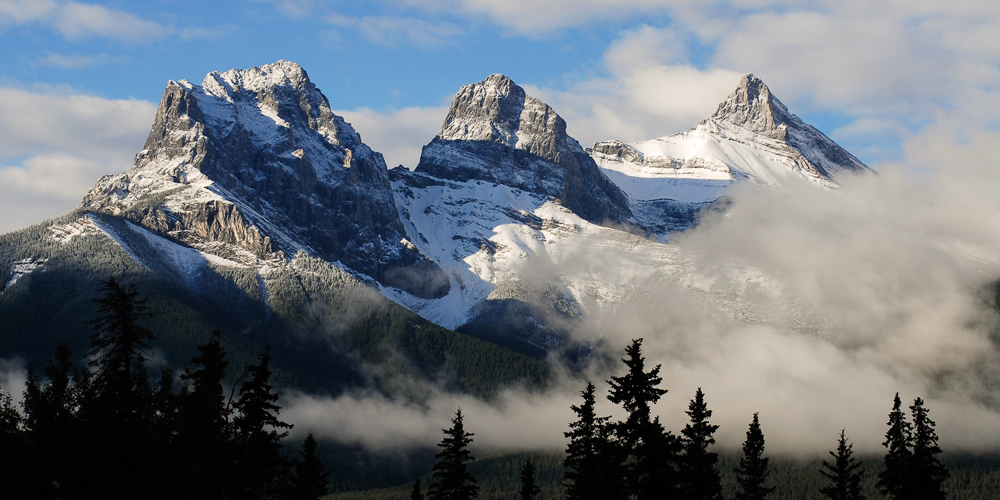Big Mountain Housing Development in Rockies Nixed
"Time to make this an election issue that puts massive scale development to bed for good"

Canmore is one of Canada’s top climbing centres, with world-class ice, alpine and cragging. It was a borderline sleepy mining town and base camp to climbers until the 1988 Olympics revealed the area’s potential to the rest of the world.
Over the past 30 years, the town has been growing at a steady rate with some homes fetching over 14 million dollars. There are many developments that have been given the green light, despite local residents opposing them, such as Silver Tip, Peaks of Grassi and Spring Creek.
However, In the past 12 months, the Three Sisters Mountain Village plan went from being a possibility to being rejected. Why? Residents and experts showed town council that the development would create too many problems. It’s a victory for environmentalists and people who don’t want to see an already crowded valley be pushed to its limit. Three Sisters Mountain Village, the developer of the project, has sought to develop the land for decades.
Canmore council rejected the application this week. All six councillors voted against the proposal, with Mayor John Borrowman casting the lone vote in favour. He is not running for re-election this fall.
“We have some very clear needs in the community that we’ve been discussing for years,” says Borrowman. “Certainly housing is a critical situation here, our housing is out of touch.”
The developments would have roughly double the size of Canmore, with estimated accommodation for approximately 14,500 additional residents. Those numbers are greater by about 25% per cent than what was proposed and rejected by town council in 2017.
The town set forth a number of amendments that would have doubled the amount of housing deemed “affordable” from 10 to 20 per cent. It also sought guarantees that commercial space would be built early in the plan which was expected to take up to 30 years to complete.
“This was never supposed to be a decision about whether development would proceed, that decision had already been made by the NRCB in 1992,” said Chris Ollenberger, director of strategy and development with Three Sisters Mountain Village. “It was supposed to be a decision about how it would proceed.”
Ollenberger said that he’s disappointed and disheartened by Tuesday’s decision. “We worked in good faith with the town and administration and council, we followed direction and guiding documents, front the town administration council including 5 years of community engagement,” he said.
Ollenberger said legal options are being considered, including an appeal to the province to step in through the Municipal Government Board. “Unfortunately we’re going to have to go down a different path and to make sure that the rights that Three Sisters already has for development in these lands can continue to be respected.”
Councillors noted impacts on wildlife as a concern, as well as the overall community and potential liabilities of building on lands undermined by historic coal operations. Canmore’s last coal mines closed in 1979, and they left large underground chambers supported by timbers that were meant to eventually rot away, causing slumping on the surface. Large sinkholes have already caused issues in the area.
The Bow Valley is part of the Yellowstone-to-Yukon region, and is one of the four most important east-west connectors in the entire 3,200-kilometre length of the region, and one of two such valleys in Alberta. Compared to the surrounding valleys, the Bow Valley is low, flat, warm, and dry, creating high quality habitat and movement corridors for animals.
With so much development in the valley bottom already, the Canmore portion of the Bow Valley serves more as a key wildlife corridor than a core habitat. This area connects the large nearby protected areas of Banff National Park and Kananaskis Country.
The Yellowstone to Yukon Conservation Initiative stated, “Without the connectivity provided by effective corridors, a single robust, healthy wildlife population can become two smaller, weaker, less resilient populations that are much more vulnerable to additional stresses such as climate change, industrial development, or even wildfire.”
“Town council today in rejecting it also made mention of a more meaningful public engagement, a visioning process for the community, and maybe even some hints at the community trying to offer to buy some of those lands to put into conservation,” said Karsten Heuer, an author and vocal opponent. “We’ve been seeing these proposals come forward for the past 30 years, and there will be others,” said Heuer.
Top local climber and author, Geoff Powter, said, “Pretty remarkable demonstration of democracy here in Canmore today. 6-1 vote against the 3rd reading of the TSMV, with passionate arguments by councillors why the voted as they did. Thanks for listening to so many of us. Now, time to make this an election issue that puts massive scale development to bed for good.”


